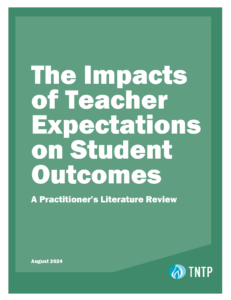A little more than five years ago, we released The Widget Effect, a report that has shaped our work ever since. Back in 2009, we did not realize it would turn out to have the policy impact it has had.
The paper identified a striking and nearly universal problem in America’s schools: a near total failure to acknowledge differences in teacher effectiveness. Each place we looked (and we examined a diverse set of 12 school districts spanning four states), we found that schools were treating teachers like interchangeable parts—as though one were the same as any other.
We called this phenomenon “the widget effect,” and it manifested itself in many different ways. Most notably, we found that virtually all teachers were rated “good” or “great” on their formal evaluations, and that almost nobody was rated poorly. We also found that teacher performance played an insignificant role in important decisions like hiring, compensation, or professional development. In fact, the only time schools seemed to care at all about a teacher’s performance is when it became so problematic as to warrant dismissal—something that almost never happened.
These trends at the district level were dismaying for two reasons. First, they ran exactly counter to the research base, which had been showing for more than a decade that teachers vary widely in their effectiveness; that the differences largely sustain themselves over time; and that the differences are consequential for students. Second, no one seemed to believe that the widget-like evaluation results were valid or felt satisfied with them. Teachers, for example, were frustrated with the lack of investment in their development and what they saw as high tolerance for poor performance among colleagues. It was a culture of indifference that seemed to undermine our schools while frustrating educators.
Based on what we learned, we recommended that states and school districts revamp their teacher evaluation systems to do their intended job: accurately and credibly distinguishing great teaching from good, good from fair, and fair from poor. Just as importantly, we recommended that school systems commit to acting on this more useful performance data by making evaluation ratings relevant in teacher placement, professional development, compensation, retention and dismissal.
So where do things stand five years later? Certainly much has changed. Just a year after we published our report, a broad policy consensus had already emerged—echoed by almost every major newspaper in the country—that teacher evaluation was broken and needed to be fixed. You’d be hard pressed to find anybody on any side of the education reform debate who will defend teacher evaluation as it existed in 2009.
The Obama administration made improving teacher evaluation systems a top priority in its Race to the Top program, which was a meaningful factor in more than 30 states deciding to adopt new teacher evaluation systems over the last five years. Early research in districts like Washington, D.C. has suggested that more credible evaluation systems really do have benefits for teachers and students alike.
But there’s a hard truth that must be admitted: the widget effect is nearly as strong today as it was in 2009. It persists in many school systems that have modernized their teacher evaluations—and in the even greater number that have made few or no changes. Across the country, nearly all teachers are still rated “good” or “great.” Most teachers are still not getting the honest feedback they deserve as professionals. Excellence is still not being recognized—not with raises, promotions, or even a pat on the back. And poor performance is still going unaddressed, to the point where we found in our 2012 report The Irreplaceables that approximately 40 percent of teachers with more than seven years of experience are performing at or below the level of a brand-new teacher.
In short, the culture of indifference toward instructional quality endures. This shouldn’t come as a surprise, since a problem that accumulated over generations was never going to disappear in a few years. Still, these early results have understandably sparked a conversation about whether all the focus on teacher evaluations has been worth it, and whether it really has the potential to transform schools for the better over the long run. We think the answer is “yes,” but the question deserves serious discussion.
So, over the next week on this blog, we’re going to reflect on where teacher evaluation stands five years after The Widget Effect—warts and all—and where it needs to go from here. You’ll be hearing our thoughts, of course, but we’ve also invited an all-star lineup of educators and policy thinkers in the field to offer their perspectives. We hope you’ll come away with a better understanding of work still ahead.
In our view, the difficulty of solving a problem like the widget effect doesn’t make it the wrong problem to solve. The right question is what can be gained by solving it. Improving teacher evaluation isn’t an end in itself, but it’s a means to some incredibly important ends—ensuring that more students have a chance to learn from great teachers, and elevating the teaching profession to the heights it deserves. After all, so long as our policies suggest that anyone can teach and any teacher is the same as the next, pay and prestige will be suppressed and many excellent candidates will choose other professions. Nobody wants to be a widget.








